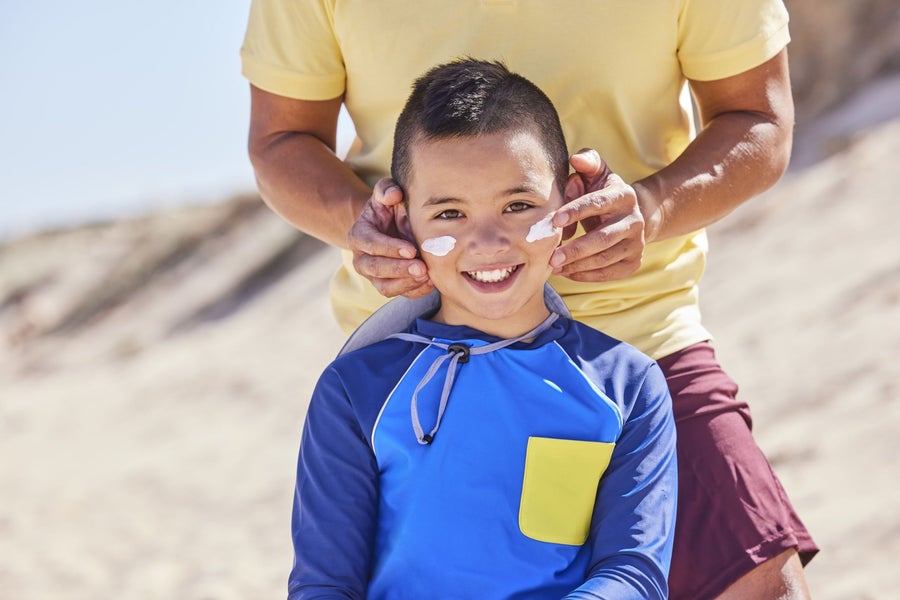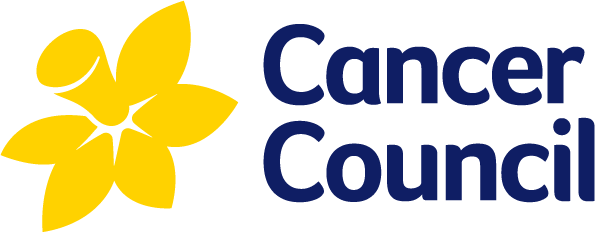All about sunscreen: 101 basics
Sunscreen basics

Australia has the highest rate of skin cancer in the world. It’s often referred to as our ‘national cancer’ (a title we’d prefer not to have). Thankfully, we know most skin cancers can be prevented. Sunscreen is one of 5 essential SunSmart steps to significantly reduce your risk, at any age. Learn how to protect your skin every day and use sunscreen when the UV is above 3 (no matter the season).
Be fully protected: Sunscreen is one step to fully protecting your skin
Sunscreen is one of 5 essential steps to prevent skin cancer. But it's not a suit of armour. For your best line of defence use it in combination with protective clothing, hats, shade and sunglasses for ultimate protection.
When the UV Index is 3 or above, be sure to protect against the sun in 5 ways:
- Slip on sun protective clothing
- Slop on SPF50 or SPF50+, broad-spectrum, water-resistant sunscreen
- Slap on a broad-brim hat
- Seek shade when possible, and
- Slide on sunglasses.
Tips for applying sunscreen
Make sunscreen part of your routine (Keys? Check. Phone? Check. Sunscreen? Check.)
For the best protection, follow these steps:
- Apply 20 minutes before going outside
- Use about 7 teaspoons for a whole body application for an adult (that’s at least one teaspoon each for your arms, legs, front, back, face/neck/ears)
- Cover every bit of exposed skin (yep, we see you ears and backs of hands!)
Reapply sunscreen to keep your protection strong:
- Reapply every 2 hours when outdoors
- Top up after swimming, sweating or towel-drying – sunscreen can rub or wash away
When UV is below 3, sunscreen isn’t needed – unless you work outside, spend long hours outdoors, or are near reflective surfaces like snow (hitting the slopes on your next holiday? Pack the sunscreen).
You can check the daily UV on your local weather forecast, via the Bureau of Meteorology, or on the SunSmart Global UV app.
For most people, adequate vitamin D levels are reached through regular incidental exposure to the sun.
For infants under six months, sunscreen is generally not recommended due to babies’ sensitive skin which may be more likely to suffer a reaction. Use shade, hats and protective clothing to keep their skin safe from the sun.
For babies older than six months, sunscreen should be used as the last line of defence, after avoiding direct sunlight, putting on covered clothing, using a hat and seeking shade.
Even 15 minutes in the sun without protection can cause damage and increase your skin cancer risk.
Using sunscreen when the UV is 3 or above – alongside clothing, hats, shade, and sunglasses – keeps your skin safe now and for the future.
Sunscreen glossary: What do all the terms mean?
- SPF: The SPF (Sun Protection Factor) number is a ‘guide’ (rather than a ‘measure’) of how well sunscreen protects the skin from sunburn.
- Water resistant: The sunscreen remains on skin during swimming or exercise, provided it’s not wiped off. While a label may state a sunscreen is '4 hours water resistant', sunscreen should still be applied every two hours to maintain optimum protection.
- Broad-spectrum: Broad-spectrum sunscreens filter both types of UV radiation, including UVA and UVB rays.
- UVA and UVB radiation: UVB is the principal cause of sunburn, but both UVA and UVB contribute to increased skin cancer risk, skin damage, and premature ageing.
- Solar UV radiation: UV radiation is not part of the visible spectrum of light and unlike sunlight it can’t be seen or felt like the sun’s warmth. As our senses can’t detect UV, overexposure can damage our skin and eyes without our knowledge.
- UV Index: The UV Index is a standardised measure used to show UV radiation intensity.
- ‘High’ vs ‘very high’ protection: According to the TGA, SPF30, 40 and 50 sunscreens give a ‘high’ level of protection. Whereas, products labelled SPF 50+ have an SPF of 60 or more, providing a ‘very high’ level of protection.
- The '+' sign: The plus (+) sign means 'more than'. It is important to note – the SPF number is a ‘guide’ rather than an exact measurement.
What is SPF?
The SPF number is a guide to a sunscreen’s protection.
It indicates how long it will take for a person exposed to the sun to suffer from sunburn compared to a person not wearing sunscreen.
When applied correctly:
- SPF 20 filters about 95% of UVB rays, allowing 5% to penetrate
- SPF 50 filters 98% allowing 2% of UVB to get through.
While Cancer Council always recommends choosing the highest possible SPF, it is important to understand the difference between SPF ratings is often misunderstood.
Even an SPF 20 sunscreen still filters approximately 95% of UVB rays, providing much better sun protection than no sunscreen at all.
SPF labels are regulated by the Therapeutic Goods Administration. The highest SPF label currently allowed on sunscreens sold in Australia is SPF50+.
What does ‘broad-spectrum’ mean?
There are different types of UV radiation. UVA radiation penetrates deep into the skin, affecting the living skin cells that lie under the skin’s surface.
- UVA causes long-term damage like wrinkles, blotchiness, sagging and roughening and also contributes to skin cancer.
- UVB radiation is the main cause of skin damage and skin cancer.
Broad-spectrum sunscreen filters both UVA and UVB radiation.
What is UV?
UV (ultraviolet) radiation is the invisible danger from the sun.
Unlike sunlight you can see or warmth you can feel, UV can damage your skin without you even knowing it – even on cloudy or cool days.
Too much UV exposure leads to sunburn, skin damage, and skin cancer.
The easiest way to know when you need sun protection is to check the UV Index. Our free SunSmart Global UV app puts this information at your fingertips.
It shows real-time and forecast UV levels for locations across Australia and around the world, and gives clear, evidence-based advice from Cancer Council Victoria on when and how to protect your skin.
How are sunscreens regulated in Australia?
Given the importance of sunscreens for Australian consumers, the Australian Government's Therapeutic Goods Administration (TGA) regulates sunscreens. This is because sunscreens are therapeutic goods with a primary purpose of providing UV protection and reducing skin cancer risk.
The TGA requires sunscreens to be tested to ensure that:
- they are safe, effective and high quality
- only pre-approved ingredients and formulations are used
- the SPF claims on the bottle are accurate, and
- the quantity of approved active ingredients is present before they are released to the public.
Unless exempt, therapeutic sunscreens must be listed or registered on the Australian Register of Therapeutic Goods (ARTG) before they can be legally supplied or sold in Australia.
Cancer Council recommends using a primary sunscreen, or a product that is primarily for protection from UV radiation. All primary sunscreens are approved for sale in Australia by the TGA.
Get advice on how to stay safe in the Aussie sun.
